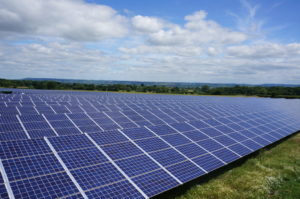
Shell has signed a deal to buy all of the power from England’s largest solar park, the 69.8MW Bradenstoke development, once RAF Lyneham, near Swindon.
The deal follows Shell’s entrance into both business and domestic energy retail and represents another small but strategic step by big oil into clean energy.
In December, BP bought a 43% share of solar firm Lightsource. Meanwhile Denmark Oil and Natural Gas (Dong) has divested fossil assets and called itself Ørsted.
Shell used to manufacture and market PV cells and made a foray into solar 17 years ago with a Siemens joint venture, before buying out its partner, and then, five years later, scrapping the idea.
However, it has recently acquired an electric vehicle charging firm and is mulling the long term future of its petrol stations. This week the firm paid £158m for a 44% in US solar company Silicon Ranch Corporation.
Compared with the likes of Ørsted, Shell remains hugely invested in oil and gas, but stated in November it will double annual investment in clean energy development to $2bn (£1.45bn), which suggests the fossil giant will announce further renewables deals in the coming months.
Growth and consolidation
The Bradenstoke power purchase agreement (PPA) was negotiated with O&M contractor, British Solar Renewables (BSR), which is majority owned by Norway-based holding company, Siem Europe SARL, which also owns the solar farm.
While policy changes last year curbed the subsidy-fuelled growth of previous years, the secondary market is buoyant, as funds fight to secure generous, long-term, index linked revenue streams. Around a fifth of UK solar farms are expected to change hands in the next year.
Graham Harding, BSR managing director and chief financial officer, told The Energyst that consolidation in the ownership of big solar would likely lead to consolidation in the operations and maintenance (O&M) market as owners seek efficiencies to maximise profit.
“Owners are looking to rationalise their O&M providers to avoid having to deal with a large number of companies to look after long-term assets. These assets need to be looked after as efficiently as possible,” said Harding. “So O&M consolidation is almost inevitable over time.”

He says despite subsidy cuts, “there is still very much a [solar] marketplace going forward,” although “not on the scale of the last few years”.
Solar, storage, money
As well as efficiencies and continued component cost reductions, Harding says co-location of storage will also influence market growth.
Investors are trying understand storage and co-location economics. However, “the challenge is that every site has its idiosyncrasies, you have to take a case-by-case basis, there is no magic bullet” or standardised approach, says Harding.
BSR now manages over half a gigawatt of solar and has significant battery storage ambition. Harding says next month’s capacity auction, into which the firm is bidding storage assets, will provide a bellwether.
“It will be interesting to see the auction outcome,” says Harding. “It is a fascinating area. It comes down to finding investors and funders that are comfortable with a level of return that is relatively consistent with solar, but that is not underpinned by a subsidised revenue stream. Everybody is looking at the returns that can be achieved. So the [auction] will be an interesting barometer of whether or not people decide to take sites forward.”
Capacity market contracts provide a small but bankable revenue stream, one which is now smaller for short duration assets following derating factors published last month.
The bigger prize is firm frequency response (FFR) contracts from National Grid. However, FFR prices are falling as firms pile in, with risk of “acute revenue compression”, according to economic consultants, Baringa Partners.
Shift happens
That compounds the challenge facing investors. But Harding believes more revenues streams will emerge. “There will be a demand for these assets,” he says, “so [investors] almost have to take a leap of faith.”
Moreover, while political risk can never be discounted, Harding suggests the current climate and recent government announcements clearly signpost the direction of travel.
That may suggest further big deals are in the offing.
“We are in an environment now where things like the clean growth strategy, the industrial strategy and the environment plan are all pointing in the same direction. That is, a shift away from coal and oil to, ideally, a world in which renewable energy is a key feature,” says Harding.
“Therefore, big organisations like BP and Shell will be looking at how they can do that. The direction of travel feels fairly clear both domestically and internationally, and I don’t think that is going to change.”
Related stories:
Free battery storage report (incl solar and storage)
Shell enters UK electricity market
BP takes big stake in solar firm Lightsource
Battery storage surge ‘to erode FFR prices by 75%’
Battery storage cut down to size as gigawatts qualify for capacity market
Better weather data and insurance hedges required for post subsidy solar?
National Grid to bring wind and solar into frequency response
Nottingham City Council: Solar ‘absolutely still viable’, batteries next
Lightsource and Blackrock go large on solar
Anesco builds ‘subsidy free’ solar and storage farm
Solar farms with batteries can keep earning Rocs
Total and Reactive Technologies launch hybrid solar PPA, seal 310MW deal
Small is beautiful, says UK’s largest solar fund
Next Energy buys 22MW of solar farms
Solar and storage must bow to grid king
As solar subsidies wane, investors plan 2.3GW of battery storage projects
17% of UK solar capacity ‘to be sold within 12-18 months’
Sheffield University launches three day solar forecasting tool
Solar PV hits 12GW, further 3GW in planning
United Utilities plans £55m solar investment
As solar generation makes history, National Grid starts to feel the burn
National Grid procures 138.6MW of demand turn up to balance solar in summer
National Grid to extend demand turn-up running hours, procure more
National Grid says impact of solar requires greater system flexibility
Follow us at @EnergystMedia. For regular bulletins, sign up for the free newsletter.



